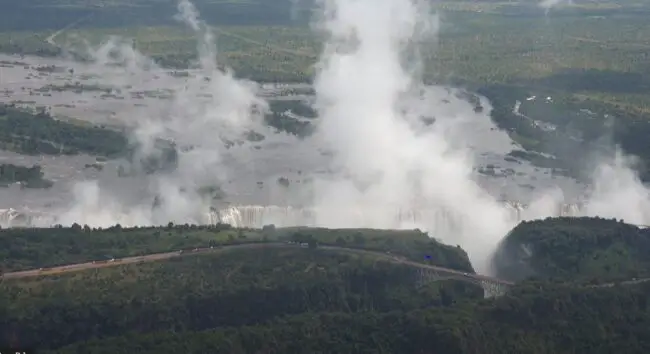The worst time to visit Victoria Falls? Brace yourself for a short and straightforward answer: the dry season. Now, hold on a moment. Before you dismiss this iconic destination altogether, let’s delve into why this seemingly unfavorable period can still offer unique experiences and breathtaking sights.
From the daunting roar of the falls to the unexpected tranquility of the surrounding wilderness, there’s a hidden allure waiting to be discovered. So, let us shed some light on why the worst time to visit Victoria Falls might just become your unexpected favorite.
Table of Contents
Worst Time to Visit Victoria Falls: A Comprehensive Guide
Located between Zambia and Zimbabwe, Victoria Falls is one of the most spectacular natural wonders in the world. Known as the “Smoke that Thunders,” this majestic waterfall attracts tourists from all around the globe. While the falls are a breathtaking sight, it’s essential to plan your visit at the right time.
In this article, we’ll explore the worst time to visit Victoria Falls, taking into account weather conditions, water levels, and other factors that can impact your experience.
1. Rainy Season: November to April
The rainy season in Victoria Falls typically runs from November to April. While some visitors may enjoy the lush greenery and vibrant landscapes during this time, there are a few reasons why this might not be the best time to visit:
- The falls are at their peak flow, which can lead to reduced visibility due to the heavy mist and spray. Taking photographs and getting clear views can be challenging.
- The rain can also make some of the trails and viewpoints slippery and muddy, making hiking and exploring more difficult.
- Mosquitoes thrive during the rainy season, increasing the risk of contracting mosquito-borne diseases like malaria.
- The constant rain can dampen the overall experience, as outdoor activities may be limited or canceled.
2. High Water Levels: February to April
Between February and April, the water levels at Victoria Falls are at their highest. While this might sound enticing, there are a few factors to consider before planning a trip during this time:
- The sheer volume of water flowing over the falls can create an intense mist that obscures the view, especially from certain viewpoints.
- With the powerful flow, the noise from the falls can be deafening and may affect your ability to fully enjoy the surroundings.
- Certain activities, such as swimming in the Devil’s Pool, are not possible or safe during high water levels.
3. Dry Season: September to November
The dry season in Victoria Falls, from September to November, might seem like an ideal time to visit, but there are a few drawbacks to consider:
- The water levels are significantly lower during this period, leading to a less impressive flow at the falls. The majestic curtain of water may be reduced to a mere trickle in some areas.
- With lower water levels, certain activities like white-water rafting may be limited or not available.
- The surrounding vegetation also tends to dry up during this season, resulting in a less picturesque landscape.
4. Hot Summer Months: October to January
The summer months between October and January can bring scorching hot temperatures to Victoria Falls. While some travelers may enjoy the warmth, there are a few reasons why this period may not be the optimal time to visit:
- High temperatures, often exceeding 100°F (38°C), can make outdoor activities uncomfortable and exhausting.
- The heat can also lead to dehydration and heat-related illnesses if proper precautions, such as staying hydrated and wearing sunscreen, are not taken.
- Wildlife viewing can be more challenging as animals tend to seek shelter during the hottest parts of the day.
5. Considerations for Photography Enthusiasts
If you are a photography enthusiast planning to capture the beauty of Victoria Falls, certain weather conditions and times of the day might be more favorable:
- Early morning or late afternoon are often considered the best times for photography as the light is softer and more flattering.
- During the rainy season, the lush greenery and vibrant rainbows can add a unique touch to your photographs, even though the falls themselves may be partially obscured.
- For long-exposure shots that capture the motion of the water, visiting during the high water levels can provide a dramatic effect.
- In contrast, the dry season may be more suitable for capturing the rocky landscape and exploring different compositions.
The worst time to visit Victoria Falls is subjective and depends on personal preferences and priorities. While the rainy season and high water levels may present challenges, they can also offer a unique experience for nature lovers. On the other hand, the dry season and hot summer months may limit some activities but provide an opportunity for a more tranquil and less crowded visit.
Consider the factors mentioned above and plan your trip accordingly to make the most of your visit to this extraordinary natural wonder.
When is the best time of year to travel to Victoria Falls? Rhino Africa’s Travel Tips
Frequently Asked Questions
Frequently Asked Questions (FAQs)
The least ideal time to visit Victoria Falls is during the dry season, particularly in the months of October and November. During this period, the water levels in the falls decrease significantly, resulting in a reduced flow of water and less impressive views.
Absolutely! While the water levels may be lower during the dry season, Victoria Falls still offers breathtaking views and plenty of activities to enjoy. You can explore the stunning rock formations and take advantage of various adventure sports, such as bungee jumping and white-water rafting.
Yes, there are some advantages to visiting Victoria Falls during the dry season. The reduced water flow allows for better visibility of the falls, as you can see the rock formations and details that may be hidden during the peak flow seasons. Additionally, activities like swimming in the Devil’s Pool are only available during low water levels.
While October and November are generally considered the worst time to visit Victoria Falls due to low water levels, it’s important to note that experiences may vary from year to year. It’s recommended to check the latest weather and water level updates before planning your trip.
The rainy season in Victoria Falls typically occurs between December and March. During this time, the falls are at their peak flow and offer a magnificent display of cascading water. However, the heavy rainfall can make some activities challenging, and the mist from the falls may obstruct the views.
Absolutely! Victoria Falls is surrounded by national parks and wildlife reserves that are home to a diverse range of animals. Even during the dry season, you can still spot elephants, buffalos, zebras, and various bird species in these areas.
No, the availability of accommodations in Victoria Falls is not significantly affected by the dry season. There are numerous hotels, lodges, and campsites that cater to visitors throughout the year. However, it’s always recommended to book in advance to secure your preferred accommodations.
Yes, you can still enjoy scenic helicopter flights over Victoria Falls during the dry season. These flights provide a unique perspective of the falls and surrounding landscapes, allowing you to appreciate their grandeur from above. However, it’s advisable to check the weather conditions and book in advance.
Final Thoughts
The worst time to visit Victoria Falls is during the dry winter months of September to November. At this time, the waterfall’s water levels are significantly reduced, resulting in a less dramatic and awe-inspiring sight. Additionally, the lack of rainfall creates a dusty and brown landscape, diminishing the overall experience.
If you want to fully appreciate the grandeur and power of Victoria Falls, it’s best to plan your visit during the wetter months, from February to May, when the waterfall is at its most magnificent. Avoid the worst time to visit Victoria Falls to ensure a breathtaking experience.






